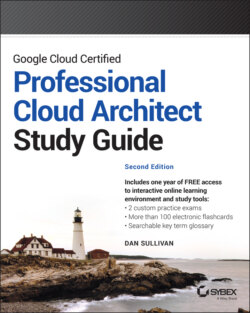Читать книгу Google Cloud Certified Professional Cloud Architect Study Guide - Dan Sullivan - Страница 36
Exam Case Studies
ОглавлениеThe Google Cloud Professional Cloud Architect certification exam uses case studies as the basis for some questions on the exam. Become familiar with the case studies before the exam to save time while taking the test.
Each case study includes a company overview, solution concept, description of existing technical environment, business requirements, and an executive statement. As you read each case study, be sure that you understand the driving business considerations and the solution concept. These provide constraints on the possible solutions.
When existing infrastructure is described, think of what GCP services could be used as a replacement if needed. For example, Cloud SQL can be used to replace an on-premises MySQL server, Cloud Dataproc can replace self-managed Spark and Hadoop clusters, and Cloud Pub/Sub can be used instead of RabbitMQ.
Read for the technical implications of the business statements—they may not be stated explicitly. Business statements may imply additional requirements that the architect needs to identify without being explicitly told of a requirement.
Also, think ahead. What might be needed a year or two from now? If a business is using batch uploads to ingest data now, what would change if they started to stream data to GCP-based services? Can you accommodate batch processing now and readily adapt to stream processing in the future? Two obvious options are Cloud Dataflow and Cloud Dataproc.
Cloud Dataproc is a managed Spark and Hadoop service that is well suited for batch processing. Spark has support for stream processing, and if you are migrating a Spark-based batch processing system, then using Cloud Dataproc may be the fastest way to support stream processing.
Cloud Dataflow supports both batch and stream processing by implementing an Apache Beam runner, which is an open source model for implementing data workflows. Cloud Dataflow has several key features that facilitate building data pipelines, such as supporting commonly used languages like Python, Java, and SQL; providing native support for exactly one processing and event time; and implementing periodic checkpoints.
Choosing between the two will depend on details such as how the current batch processing is implemented and other implementation requirements, but typically for new development, Cloud Dataflow is the preferred option.
The case studies are available online here:
EHR Healthcare services.google.com/fh/files/blogs/master_case_study_ehr_healthcare.pdf
Helicopter Racing League services.google.com/fh/files/blogs/master_case_study_helicopter_racing_league.pdf
Mountkirk Games services.google.com/fh/files/blogs/master_case_study_mountkirk_games.pdf
TerramEarth services.google.com/fh/files/blogs/master_case_study_terramearth.pdf
The case studies are summarized in the following sections.
